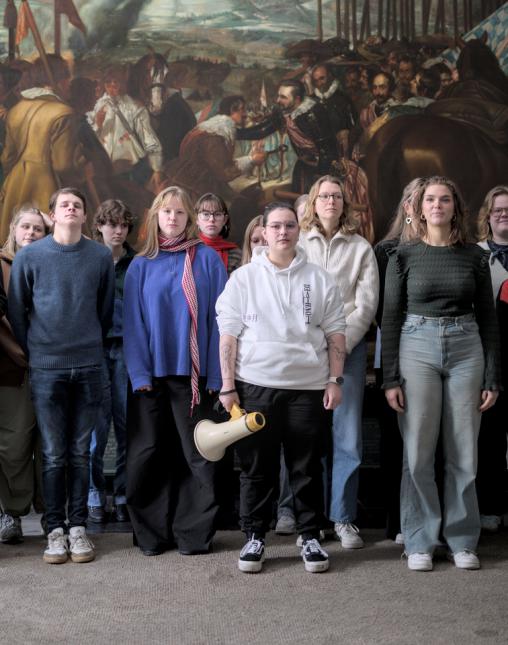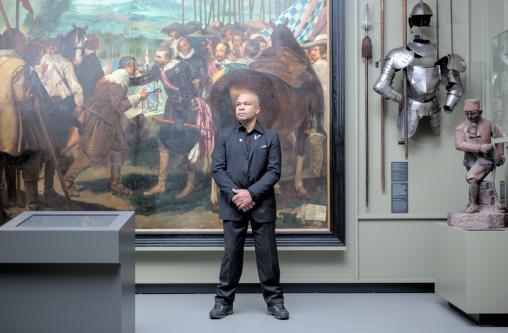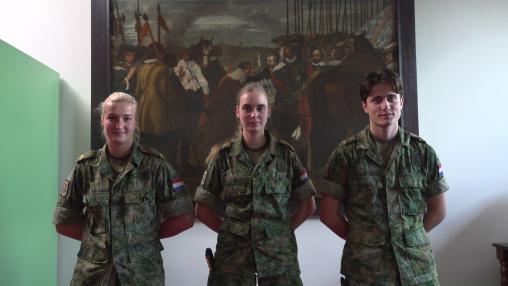Teatro de Sombras
Un tríptico sobre relaciones de poder, representación y la larga sombra de la historia.
Teatro de Sombras es una instalación con tres canales de vídeo, y el resultado artístico de dos años de investigación en torno a las copias de La Rendición de Breda de Diego Velázquez, así como de los espacios semi-públicos en los que se exhiben estas copias en la ciudad holandesa. El proyecto parte de la premisa de que el contexto determina el significado de una obra de arte. El original, por ejemplo, se encuentra en el Museo del Prado en Madrid y celebra la victoria de los españoles tras el Sitio de Breda. En cambio, en el Museo Stedelijk de Breda, la ‘derrota’ no impide que una de las copias ocupe un lugar central de la exposición dedicada a la grandeza de la familia real Orange-Nassau. Y finalmente, la copia exhibida en el Ayuntamiento de la ciudad sirve de fondo para cientos de fotos de bodas civiles que se celebran allí al año.
La instalación reúne las diferentes copias del cuadro una junto a la otra, destacando situaciones cotidianas que ocurren alrededor de ellas. En el museo municipal, por ejemplo, el equipo de conservadores cuelga cuidadosamente un lienzo de Kees Maks de 1903 en su ubicación dentro de la exposición permanente. En el Ayuntamiento, estudiantes de la Escuela de Arte y Diseño St. Joost recrean una manifestación de okupas de los años 70 frente a la copia realizada por Fernando Coll en 1931. En el Museo del Prado, diplomáticos de la Embajada de los Países Bajos en Madrid posan ante el original de 1634, mientras que en la Academia Militar, cadetes uniformados se cuadran ante la copia de André-Julien Prévost, de 1872.
El artista Roel Meelkop ha compuesto el paisaje sonoro de la instalación, acentuando o distorsionando la acústica de cada espacio, enfatizando así la distancia entre el público y las imágenes.
Teatro de Sombras fusiona pasado y presente, el acto de observar y ser observado, y abre la puerta a nuevas interpretaciones de esta escena bélica centenaria pintada por Velázquez.
Este proyecto ha sido realizado durante una residencia de investigación en Witte Rook, gracias los apoyos del Ayuntamiento de Breda, el Mondriaan Fund, la Embajada de los Países Bajos en España y el Instituto Cervantes de Utrecht. Con agradecimientos al Museo Stedelijk de Breda, Museo del Prado en Madrid, Museo Helmond, Escuela de Arte y Diseño St. Joost, la Real Academia Militar Holandesa y el Archivo Municipal de Breda.
Un agradecimiento especial a: Anja Bastiaansen-Jochems, Boudewijn van de Calseijde, Bernardo García García, Cato van Gorkum, Lisanne van Happen, Nikkie Herberigs, Justin Kroesen, Ana Martín Bravo, Verónica Montes, Susan Nash, Bernardo Pajares Duro, Javier Portús Pérez, Max van Rosmalen, Carmen Santos, Hannah Schildt, Frederique Scholtes, Marjolein van de Ven, Stan Wullffaert, Miguel Zugaza Miranda y los todos los participanets.








